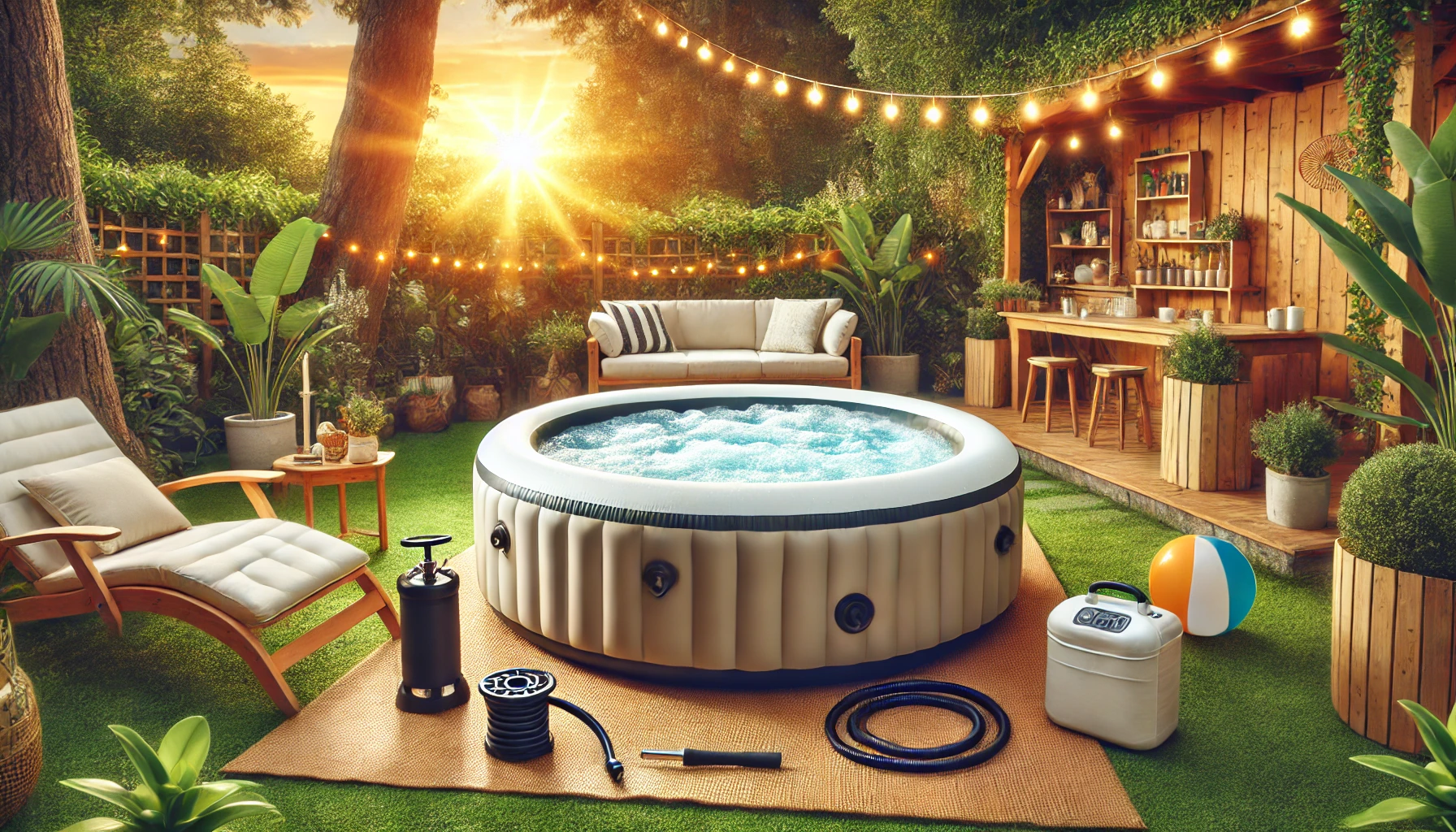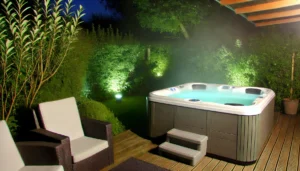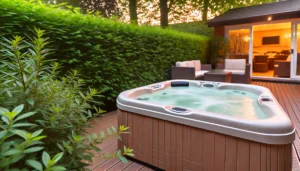Let me tell you, there’s nothing quite like sinking into a warm, bubbly hot tub after a long day. And get this – inflatable hot tubs are taking the relaxation world by storm!
Did you know that sales of these portable paradises jumped by a whopping 70% in 2020 alone? It’s crazy!
But here’s the thing: as much as I love my inflatable hot tub, I’ve noticed something that used to drive me nuts. Sometimes, it seems like it’s losing air for no reason at all.
Now, if you’re anything like me, you might be wondering, “Do inflatable hot tubs naturally lose air, or am I just imagining things?”
Well, my friend, you’re not alone in this bubbly predicament. It’s a question that’s been floating around (pun intended) in hot tub forums and backyard discussions for years.
In this article, we’re going to dive deep into the world of inflatable hot tubs and uncover the truth about air loss.
Trust me, I’ve been through the frustration of constantly refilling my tub, and I’m here to share all the juicy details I’ve learned along the way.
We’ll explore why these tubs might lose air, how to spot the signs, and most importantly, what you can do about it.
So grab your favorite drink, maybe even a rubber ducky, and let’s get to the bottom of this mystery.
By the time we’re done, you’ll be armed with all the knowledge you need to keep your inflatable oasis in tip-top shape.
Who knows? You might even become the go-to hot tub guru in your neighborhood! Let’s make a splash and get started!
Do Inflatable Hot Tubs Naturally Lose Air?

Yes, inflatable hot tubs do naturally lose air over time.
This gradual air loss is due to several factors, including the porosity of the PVC or vinyl material, temperature fluctuations causing the air to contract, and the constant pressure from the water and users.
On average, you might need to top up the air in your inflatable hot tub every 3-5 days, depending on usage and environmental conditions.
While some air loss is normal and expected, excessive or rapid deflation could indicate a leak or other issue that needs attention.
Stick around as we dive deeper into the bubbly world of inflatable hot tubs and uncover the secrets to keeping them perfectly plump and ready for your next relaxing soak!
The Science Behind Air Loss in Inflatable Hot Tubs
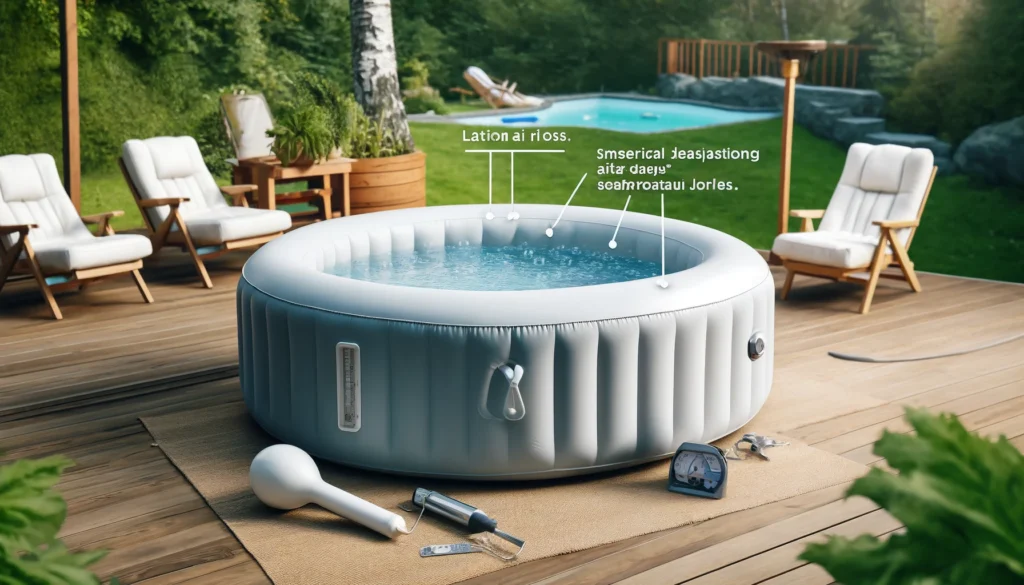
Alright, folks, let’s get our geek on for a minute! I remember when I first got my inflatable hot tub, I thought I was going crazy. I’d fill it up, and a few days later, it’d feel a bit… saggy.
What gives? Well, turns out there’s some pretty cool science behind why these tubs might lose air over time.
First up, let’s talk about material porosity. Now, don’t let that fancy term scare you off – it’s just a nerdy way of saying that the material your tub is made of (usually PVC or vinyl) has teeny-tiny spaces in it.
Imagine a sponge, but on a microscopic level. Over time, air can slowly seep through these itty-bitty holes. It’s like trying to keep a secret – eventually, it’s gonna leak out!
But wait, there’s more! Temperature changes are another sneaky culprit. Picture this: you’re enjoying a nice, hot soak on a cool evening.
The air inside your tub is all warm and cozy, but the outside air is chilly. This temperature difference can cause the air inside to contract when it cools down, making it seem like you’ve lost some air.
I learned this the hard way when I thought my tub was deflating, but it was just the morning chill playing tricks on me!
Now, here’s something that blew my mind when I first learned about it – water pressure and weight can actually affect air loss too.\
When you fill your tub with water and hop in, all that weight pushes down on the air chambers.
It’s like sitting on a balloon – the air has to go somewhere! This pressure can force some air out through those tiny pores we talked about earlier.
Oh, and get this – altitude can make a difference too!
If you’re lucky enough to have your inflatable hot tub up in the mountains (jealous!), the lower air pressure at higher altitudes can make it seem like your tub is losing air faster.
It’s not – there’s just less atmospheric pressure pushing back against it. Mind. Blown.
So, there you have it – the science behind why your inflatable hot tub might be losing air. It’s not just you, and it’s not just your tub.
It’s physics, baby! But don’t worry, we’re not done yet. Knowing why it happens is half the battle.
Stick around, and I’ll share some tips on how to deal with it. Trust me, once you get the hang of it, it’s no biggie. Now, who’s ready for another soak?
Common Causes of Air Loss

Alright, hot tub buddies, let’s dive into the nitty-gritty of why your inflatable oasis might be losing its puff.
Trust me, I’ve been there, scratching my head and wondering if I’m doing something wrong. Spoiler alert: sometimes it’s not your fault at all!
First up, we’ve got good ol’ wear and tear. Just like your favorite pair of jeans, inflatable hot tubs can start to show their age over time.
I remember when I first noticed a tiny air loss in my tub – I felt like I’d personally failed it somehow!
But nope, it’s just a natural part of the tub’s life cycle. Those materials we talked about earlier?
They can start to break down a bit, especially if you’re a hot tub enthusiast like me who uses it all the time. No shame in our game!
Now, here’s where I have to fess up to a rookie mistake. Improper setup and maintenance can be a sneaky cause of air loss.
I learned this the hard way when I first set up my tub on a slightly uneven surface. Big mistake!
The uneven pressure can cause certain areas to wear out faster. And don’t even get me started on the time I forgot to clean the filter for way too long. Yikes! Proper care is key, folks.
Let’s chat about Mother Nature for a sec. Environmental factors can play a huge role in air loss. I once left my tub uncovered during a particularly sunny week (I know, I know, rookie move), and the UV rays did a number on the material, making it more prone to tiny leaks.
And don’t even get me started on the time a stray twig poked a teeny hole in my tub. Always check your setup area for sharp objects!
Lastly, and this one’s a bummer, sometimes it’s just down to manufacturing defects. It’s rare, but it happens.
I had a buddy who got a tub with a faulty valve right out of the box. Talk about a letdown! But the good news is, most reputable companies will take care of you if this happens.
The takeaway here? Some air loss is normal and even expected. But excessive loss? That’s when you need to put on your detective hat and figure out what’s going on.
Don’t worry, though – we’re in this together! Stay tuned, and I’ll share some tips on how to spot these issues before they become big problems.
Who knew being a hot tub owner could make you feel like a CSI investigator?
How to Detect Air Loss in Your Inflatable Hot Tub
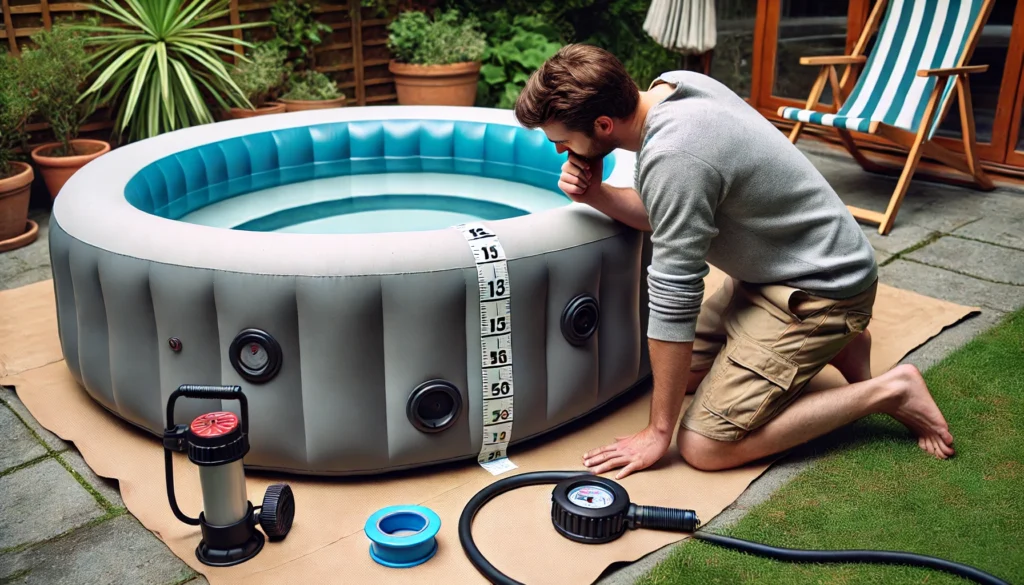
Alright, hot tub detectives, it’s time to put on your sleuthing caps! Detecting air loss in your inflatable hot tub isn’t rocket science, but it does require a keen eye and a bit of patience.
Trust me, I’ve turned into a regular Sherlock Holmes when it comes to my tub!
First things first, let’s talk about the signs of low air pressure. You know that feeling when you sit on a partially deflated air mattress?
Yeah, it’s kinda like that. If your once-firm tub walls are starting to feel a bit squishy or you’re sinking deeper into the water than usual, that’s a big red flag.
I remember the first time I noticed this – I thought I was just extra relaxed, but nope, my tub was losing air!
Now, here’s a simple test I swear by. Fill your tub with water to the normal level and mark it with a waterproof marker or some tape. Come back in 24 hours and check if the water level has dropped significantly.
If it has, you might have a leak. Just make sure no one’s been sneaking in for a midnight soak – I once accused my tub of leaking only to find out my neighbor had been enjoying a cheeky dip!
Another trick I learned the hard way: listen for hissing. One time, I was relaxing in my tub and heard what I thought was a snake nearby.
Turns out, it was just a tiny puncture letting out air! So, turn off those jets, get the area nice and quiet, and give your tub a good listen. You might be surprised what you hear.
But here’s the million-dollar question: when should you be concerned? Well, if you’re having to top up the air more than once a week, that’s usually a sign something’s up.
A little air loss here and there is normal – remember that science stuff we talked about earlier? But if you’re constantly reaching for that pump, it’s time to do some investigating.
Oh, and here’s a pro tip: keep a log of when you inflate your tub. I know, I know, it sounds super nerdy (and it is), but trust me, it helps.
You’ll start to see patterns and can catch issues early. Plus, it makes you feel like a real hot tub expert!
Remember, folks, a little vigilance goes a long way. By keeping an eye (and an ear) out for these signs, you can catch air loss early and save yourself a lot of headaches down the road.
Stay tuned, because next up, I’ll share some tips on how to prevent these pesky air losses in the first place. Who’s ready to become a hot tub maintenance master?
Preventing Excessive Air Loss

Alright, hot tub enthusiasts, let’s talk prevention! Because let’s face it, nobody wants to spend more time pumping up their tub than actually enjoying it.
I’ve learned a thing or two about keeping that air where it belongs, and I’m gonna spill all the beans. Get ready for some game-changing tips!
First up, let’s chat about proper inflation techniques. I used to think that pumping my tub as full as possible was the way to go. Boy, was I wrong!
Overinflation is like overstuffing your suitcase – something’s bound to pop. Now, I always follow the manufacturer’s guidelines to a T.
And here’s a little secret: I like to inflate my tub on a warm day. The air expands in heat, so if you inflate on a hot day, you might find your tub a bit saggy when it cools down.
Maintenance is key, folks. I know, I know, it’s not the fun part, but trust me, your future self will thank you. I make a habit of wiping down my tub regularly to prevent any buildup that could degrade the material.
And don’t even get me started on chemical balance! I once let my pH levels go wonky, and it was like an all-you-can-eat buffet for bacteria that could weaken the tub material. Now I check those levels religiously.
Let’s talk about protecting your tub from the elements. I learned this lesson the hard way when I left my tub uncovered during a particularly nasty hailstorm.
Ouch! Now, I always use a cover when the tub’s not in use. It’s like tucking your tub in for a good night’s sleep. Plus, it helps maintain the temperature, which is a win-win in my book.
Here’s something that might surprise you: the ground beneath your tub matters! I once set up my tub on a spot with some sneaky little rocks hidden in the grass.
Bad move! Now, I always lay down a ground cloth first. It’s like giving your tub a nice, soft bed to rest on.
Oh, and regular inspections are crucial. I make it a point to give my tub a once-over every few weeks.
I run my hands along the seams, check the valves, and just generally look for anything out of the ordinary.
It’s like a spa day for your spa! Plus, it’s a great excuse to get up close and personal with your tub.
Remember, prevention is always easier than cure. One time, I caught a tiny pinprick hole during my routine inspection.
Fixed it in a jiffy with a repair kit, and saved myself from a potential disaster. It’s like they say, a stitch in time saves nine – or in this case, saves your Saturday night soak!
Now, let’s talk about temperature management. I used to be that guy who cranked the heat up to max every time.
Bad idea! Extreme temperature changes can stress the material and lead to faster air loss.
These days, I keep it at a consistent, comfy temperature. It’s better for the tub and, honestly, better for my energy bill too!
Here’s a quirky tip I picked up from a fellow hot tub enthusiast: use a floating thermal blanket.
It’s like a cozy jacket for your water! It helps maintain temperature and reduces evaporation, which in turn reduces stress on your tub.
Plus, it makes me feel like I’m giving my tub a little hug every time I use it.
Oh, and let’s not forget about proper storage when you’re not using your tub for extended periods. I once made the mistake of deflating my tub and shoving it in a damp corner of the garage for the winter.
Big mistake! Now, I always make sure it’s bone dry before storing, and I keep it in a cool, dry place away from any potential puncture hazards. It’s like sending your tub on a nice vacation!
Lastly, don’t underestimate the power of a good cleaning routine. I’m not just talking about the water here, folks.
Every few months, I drain my tub completely and give it a good scrub down. It’s like a spa day for your spa!
This not only keeps it hygienic but also allows you to really inspect every nook and cranny for potential issues.
Remember, a little TLC goes a long way in preventing air loss. It might seem like a lot of work, but trust me, it’s worth it when you’re enjoying a perfectly inflated, bubble-filled paradise on a starry night.
Stay tuned, because next up, we’ll dive into what to do if prevention doesn’t quite cut it and you need to fix a leak. Don’t worry, I’ve got you covered!
Fixing Air Leaks in Inflatable Hot Tubs
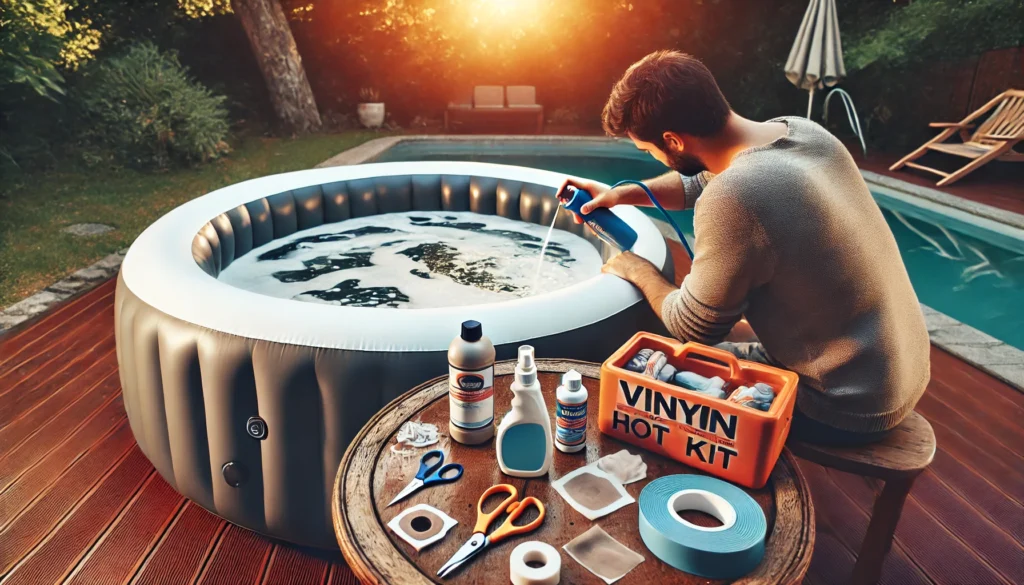
Alright, fellow hot tub lovers, it’s time to roll up our sleeves and talk about the dreaded L-word: leaks.
Don’t panic! I’ve been there, done that, and I’m here to tell you that most leaks are totally fixable. Let’s dive into some DIY repair methods that’ll have your tub bubble-ready in no time.
First things first, you gotta find that pesky leak. My go-to method? A mixture of dish soap and water in a spray bottle.
I felt like a mad scientist the first time I tried this! Spray it on your deflated tub and watch for bubbles. Where you see bubbles forming, that’s your leak. It’s like a fun, soapy treasure hunt!
Once you’ve located the leak, it’s repair kit time. Now, I’ll be honest, the first time I used a vinyl repair kit, I made a mess.
But practice makes perfect! Clean and dry the area around the leak, cut your patch to size (make it bigger than the hole), and apply according to the kit’s instructions.
Pro tip: let it cure for longer than you think you need to. Trust me on this one – patience is a virtue when it comes to tub repair.
But what if the leak is in a tricky spot, like a seam? This is where it gets a bit trickier. I once had a leak right on a seam and thought my tub days were over.
But fear not! There are special seam sealers out there that work wonders. Just be sure to follow the instructions to a T. It’s like performing surgery on your tub – precision is key!
Now, let’s talk about when to wave the white flag and call in the pros. If you’ve got multiple leaks, or if that stubborn hole just won’t stay patched, it might be time to admit defeat.
I learned this lesson the hard way after my third attempt at fixing a particularly nasty tear.
Sometimes, it’s worth investing in professional repair to save your sanity (and your pruney fingers).
Oh, and here’s a hot tip: always keep a repair kit on hand. You never know when you might need it, and trust me, you don’t want to be running to the store in your swimsuit when you’ve got a tub full of water and a slow leak.
Been there, done that, got the weird looks from the cashier.
Lastly, let’s talk prevention. After you’ve fixed a leak, keep an eye on that spot. Sometimes, it can be the canary in the coal mine, warning you of weak spots in your tub.
I once had a leak that kept coming back, and it turned out to be a sign that my tub was reaching the end of its lifespan. It was a sad day, but hey, it gave me an excuse to upgrade!
Remember, fixing leaks is part of the hot tub journey.
It might feel frustrating at times, but think of it this way: every successful repair is a battle scar that makes you a true hot tub warrior.
So don your repair kit like armor, and tackle those leaks with confidence. You’ve got this!
Conclusion: Mastering Your Inflatable Hot Tub
Whew! We’ve been on quite the journey, haven’t we? From diving into the bubbly science of air loss to becoming DIY repair experts, we’ve covered it all.
Now, let’s take a moment to soak in everything we’ve learned (pun totally intended).
First off, remember that some air loss in your inflatable hot tub is totally normal. It’s not you, it’s not your tub, it’s just physics doing its thing.
But that doesn’t mean we have to sit back and let our tubs deflate into sad puddles of disappointment!
By staying vigilant and catching those sneaky leaks early, you’re already halfway to hot tub nirvana.
Regular check-ups, proper maintenance, and a little TLC go a long way in keeping your inflatable oasis in tip-top shape.
Think of it as bonding time with your tub – the more love you give it, the more relaxing soaks it’ll give you in return.
And hey, even if you do end up with a leak, it’s not the end of the world.
Armed with your trusty repair kit and the knowledge you’ve gained, you’re more than equipped to tackle most issues that come your way.
Remember, every successful repair is a badge of honor in the world of inflatable hot tub ownership!
Now, I want you to take this knowledge and make it your own. Every tub is unique, just like every hot tub owner.
Maybe you’ll discover a genius hack for preventing leaks, or come up with a creative way to protect your tub from the elements.
Don’t be afraid to experiment (safely, of course) and find what works best for you and your bubbly buddy.
Oh, and let’s not forget about safety. Always make sure your tub is on stable ground, keep those chemicals balanced, and never, ever use electrical devices near your tub.
Your relaxation shouldn’t come at the cost of your well-being!
Lastly, I want to encourage you to share your own experiences and tips. Got a crazy leak story?
A miraculous fix? Share it with your fellow hot tub enthusiasts! We’re all in this together, creating a community of inflatable hot tub aficionados.
Who knows, your tip might just save someone else’s soak!
So, here’s to many more nights of stargazing from the comfort of your perfectly inflated hot tub.
May your water be warm, your bubbles plentiful, and your air pressure always just right. Now, if you’ll excuse me, I think it’s time for a nice, long soak.
Care to join me?
